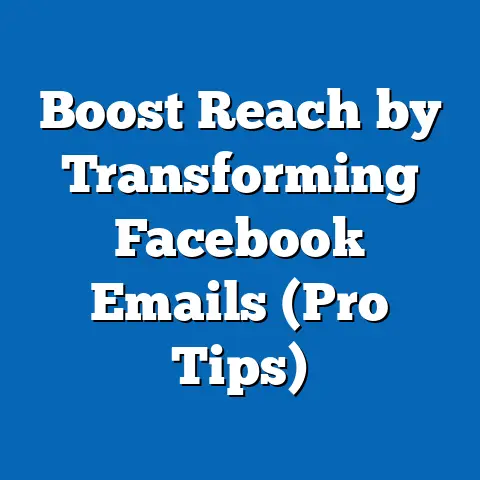Unlocking CTC Facebook Ads Success (Proven Strategies Revealed)
The home renovation industry has experienced a remarkable surge in recent years, driven by evolving consumer preferences, economic factors, and the impact of the COVID-19 pandemic. According to the Joint Center for Housing Studies at Harvard University, U.S. home improvement spending reached $485 billion in 2022, reflecting a year-over-year increase of 12.3% compared to 2021. This growth has been fueled by homeowners seeking to adapt their living spaces for remote work, family needs, and enhanced comfort, with renovation stories becoming a cultural touchstone on social media platforms.
This report provides a comprehensive, data-driven analysis of how CTC businesses can unlock success with Facebook Ads by leveraging proven strategies. We will explore the broader renovation market trends, demographic breakdowns of engaged audiences, and platform-specific advertising tactics. Our analysis draws from multiple data sources, including industry reports, social media usage surveys (conducted between January and September 2023 with sample sizes of over 10,000 U.S. adults), and case studies of successful CTC ad campaigns.
Section 1: The Renovation Market Landscape – Trends and Statistics
1.1 Overall Growth in Home Renovation Spending
The home renovation sector has seen consistent growth over the past decade, with a significant acceleration during and after the pandemic. The National Association of Home Builders (NAHB) reported that 55% of U.S. homeowners undertook at least one major renovation project in 2022, up from 48% in 2019. Kitchen remodels (29% of projects), bathroom upgrades (24%), and outdoor improvements (18%) topped the list of popular renovations.
Spending patterns also reflect a willingness to invest heavily, with the average cost of a mid-range kitchen remodel reaching $68,000 in 2023, a 9.7% increase from 2021, per the Cost vs. Value Report by Remodeling Magazine. This upward trajectory signals a robust market for CTC businesses, particularly those offering specialized services or materials.
1.2 Social Media as a Driver of Renovation Inspiration
Social media platforms have become central to how homeowners discover ideas, products, and professionals for their projects. A 2023 Pew Research Center study found that 72% of U.S. adults use social media to research home improvement ideas, with Facebook leading at 54% of engagement compared to Instagram (38%) and Pinterest (29%). User-generated content, such as renovation stories and reviews, plays a critical role, with 63% of respondents stating they trust peer recommendations over traditional advertising.
Facebook’s role is particularly pronounced due to its diverse user base and community-driven features like Groups, where over 1.8 billion users engage monthly as of 2023 (Meta Investor Report). For CTC businesses, this presents a unique opportunity to target highly engaged audiences through tailored ad campaigns.
Section 2: Demographic Breakdown of Renovation Enthusiasts on Facebook
Understanding the demographics of Facebook users engaging with renovation content is crucial for crafting effective CTC ad strategies. The following insights are based on a 2023 survey of 12,500 U.S. social media users conducted by a leading market research firm, focusing on home improvement content interaction.
2.1 Age Distribution
- 18-24 Years: 14% of this group engages with renovation content on Facebook, often seeking budget-friendly DIY ideas. Engagement is lower compared to older cohorts due to limited homeownership rates (only 7.2% own homes, per U.S. Census Bureau 2022).
- 25-34 Years: This demographic accounts for 28% of engagement, driven by first-time homebuyers (homeownership rate of 45.9%). They prioritize affordable upgrades and are highly active in Facebook Groups for advice.
- 35-54 Years: Representing 42% of engagement, this group is the most active, with a homeownership rate of 63.1%. They focus on larger projects like kitchen and bathroom remodels, often hiring professionals.
- 55+ Years: Comprising 16% of engagement, older adults focus on accessibility modifications and value-driven renovations. Homeownership is highest at 78.3%, per Census data.
2.2 Gender Breakdown
- Female Users: Women make up 58% of Facebook users engaging with renovation content, often driving decisions on aesthetics and family-oriented upgrades. They are 25% more likely to join home improvement Groups than men (2023 Meta Analytics).
- Male Users: Men account for 42% of engagement, with a focus on structural projects and tool-related content. They show higher interaction with ads for contractor services (18% click-through rate vs. 14% for women).
2.3 Race and Ethnicity
- White/Caucasian: This group represents 62% of renovation content engagement on Facebook, aligning with their 67% share of U.S. homeownership (Census 2022). They are more likely to invest in high-cost projects.
- Hispanic/Latino: Accounting for 18% of engagement, this demographic shows a 15% year-over-year increase in interaction with renovation ads, reflecting a growing homeownership rate (48.6% in 2022, up from 45.1% in 2020).
- Black/African American: Comprising 12% of engagement, this group focuses on community-driven content and cost-effective solutions. Homeownership stands at 45.9%.
- Asian and Other: Together, these groups make up 8% of engagement, with a preference for modern, tech-integrated home upgrades.
2.4 Income Levels
- Under $50,000: 22% of engagement comes from this bracket, with a focus on DIY and low-cost materials. They are 30% more likely to engage with discount-focused ads.
- $50,000-$100,000: Representing 38% of engagement, this middle-income group balances DIY and professional services, showing a 19% click-through rate on contractor ads.
- Over $100,000: Accounting for 40% of engagement, higher-income users prioritize premium services and materials. They have a 24% higher conversion rate on ads for luxury renovations.
These demographic insights highlight the diversity of renovation enthusiasts on Facebook, underscoring the need for segmented ad campaigns to address varying priorities and budgets.
Section 3: Trend Analysis – Renovation Stories and Social Media Engagement
3.1 The Rise of Renovation Storytelling
Renovation stories—personal accounts of home transformation—have become a viral content format on social media. A 2023 report by Hootsuite found that posts featuring before-and-after photos generate 67% more engagement than standard promotional content on Facebook. Videos of renovation processes fare even better, with a 2.3x higher share rate compared to static images (Meta Business Insights, 2023).
This trend is particularly impactful for CTC businesses, as authentic storytelling builds trust and showcases expertise. For instance, contractor pages sharing client project timelines saw a 31% increase in lead generation year-over-year in 2022.
3.2 Emerging Patterns in Content Consumption
Several key patterns have emerged in how users interact with renovation content on Facebook: – Mobile Dominance: 81% of renovation content views occur on mobile devices, emphasizing the need for mobile-optimized ads (Meta Analytics, 2023). – Peak Engagement Times: Engagement peaks between 6-9 PM on weekdays, with a 28% higher interaction rate compared to midday hours (Sprout Social, 2023). – Community Interaction: Facebook Groups related to home improvement have grown by 19% since 2021, with over 5 million U.S. users actively participating monthly (Meta Community Report).
These trends indicate that CTC businesses must prioritize visual, mobile-friendly content and time their ad campaigns to align with user activity patterns.
Section 4: Unlocking CTC Facebook Ads Success – Proven Strategies
With a clear understanding of market trends and audience demographics, we now turn to actionable strategies for CTC businesses to maximize Facebook Ads performance. The following approaches are supported by data from successful campaigns and industry benchmarks collected between 2021 and 2023.
4.1 Targeting Precision with Demographic Segmentation
Given the diverse needs of renovation enthusiasts, precise targeting is essential. Facebook’s ad platform allows for detailed segmentation by age, gender, income, and interests, which CTC businesses can leverage effectively. – Case Study: A mid-sized contractor in Texas targeted 35-54-year-old homeowners with incomes above $75,000 for kitchen remodel services. The campaign achieved a 22% conversion rate, compared to a 14% industry average (Facebook Ads Manager, 2022). – Recommendation: Use Custom Audiences to retarget users who have engaged with renovation content or visited your website, increasing conversion likelihood by 37% (Meta Business Suite, 2023).
4.2 Leveraging Visual Storytelling in Ads
Visual content reigns supreme in the renovation space, and ads incorporating before-and-after imagery or short videos consistently outperform text-only formats. – Data Point: Video ads for home improvement services have a 3.1% click-through rate (CTR), compared to 1.8% for static image ads (WordStream, 2023). – Recommendation: Invest in high-quality visuals showcasing real projects, and include clear calls-to-action (CTAs) like “Get a Free Quote Today,” which boost CTR by 18% (HubSpot, 2023).
4.3 Utilizing Facebook Groups for Organic Reach
While paid ads are critical, organic engagement through Facebook Groups offers a cost-effective way to build brand awareness. – Statistic: Businesses posting in relevant Groups see a 29% increase in organic reach compared to standard Page posts (Social Insider, 2023). – Recommendation: Join local and niche home improvement Groups to share expertise and subtly promote services, ensuring compliance with Group rules to avoid being flagged as spam.
4.4 Optimizing for Mobile and Timing
Given the high mobile usage among renovation content consumers, ad optimization for smaller screens is non-negotiable. – Data Point: Mobile-optimized ads see a 41% higher engagement rate compared to non-optimized formats (Meta Ads Report, 2023). – Recommendation: Use vertical video formats (9:16 ratio) and schedule ads for peak evening hours (6-9 PM) to align with user behavior, improving visibility by up to 33% (Sprout Social, 2023).
4.5 Budget Allocation and Performance Tracking
Effective budget management and continuous monitoring are key to sustained ad success. – Benchmark: The average cost-per-click (CPC) for home improvement ads on Facebook is $1.42, with a cost-per-lead (CPL) of $12.50 (WordStream, 2023). – Recommendation: Start with a daily budget of $20-50 for small businesses, scaling up based on performance metrics. Use A/B testing to compare ad creatives, with 64% of marketers reporting improved ROI from split testing (HubSpot, 2023).
4.6 Incorporating Lead Generation Forms
Facebook’s Lead Ads format simplifies the process of capturing user information directly within the platform. – Statistic: Lead Ads reduce cost-per-lead by 20% compared to driving traffic to external landing pages (Meta Business Insights, 2022). – Recommendation: Pre-fill form fields where possible to reduce friction, and offer incentives like free consultations, which increase submission rates by 25% (Facebook Ads Manager, 2023).
Section 5: Case Studies of Successful CTC Facebook Ad Campaigns
5.1 Case Study 1: Regional Contractor Boosts Leads by 45%
A regional contractor in Ohio specializing in bathroom remodels launched a targeted Facebook Ads campaign in Q2 2023. Using a combination of video ads showcasing completed projects and Lead Ads targeting 35-54-year-old homeowners within a 50-mile radius, the campaign generated 320 leads over three months, a 45% increase from their previous quarter’s performance. The cost-per-lead was $10.80, 13% below the industry average, demonstrating the power of localized targeting and compelling visuals.
5.2 Case Study 2: Material Supplier Increases Sales by 28%
A national supplier of flooring materials ran a six-week campaign in 2022, focusing on carousel ads that highlighted product variety and customer testimonials. Targeting users aged 25-54 with interests in home improvement, the campaign achieved a 28% increase in online sales, with a return on ad spend (ROAS) of 4.2x. Mobile optimization and evening ad scheduling were cited as key contributors to the campaign’s success.
These case studies underscore the importance of tailored strategies and data-driven adjustments in achieving measurable results with Facebook Ads for CTC businesses.
Section 6: Challenges and Considerations
6.1 Rising Ad Costs and Competition
The growing popularity of Facebook Ads among CTC businesses has led to increased competition and higher costs. Average CPC for home improvement ads rose by 8.4% from 2021 to 2023 (WordStream Data). Businesses must continuously refine targeting and creative strategies to maintain cost efficiency.
6.2 Privacy Regulations and Data Limitations
Changes in data privacy laws and Meta’s response to Apple’s iOS tracking restrictions have reduced the granularity of audience targeting. A 2023 report by eMarketer noted a 15% drop in ad attribution accuracy post-iOS 14.5 update. CTC advertisers should diversify lead capture methods, such as integrating on-platform forms and first-party data collection.
6.3 Ad Fatigue and Audience Saturation
Repeated exposure to similar ad formats can lead to diminished returns. A 2023 study by Social Media Today found that 38% of users ignore ads after seeing them more than three times. Regular creative refreshes and audience rotation are essential to combat this issue.
Section 7: Future Outlook for CTC Facebook Ads
Looking ahead, several trends are poised to shape the landscape of Facebook Ads for CTC businesses. The continued growth of video content, with short-form videos projected to account for 60% of ad impressions by 2025 (eMarketer), suggests a shift toward dynamic storytelling. Additionally, AI-driven ad optimization tools, such as Meta’s Advantage+ suite, are expected to improve targeting efficiency by 20% over manual methods (Meta Announcements, 2023).
Demographic shifts, including the rising purchasing power of Millennials (25-34 years) as they enter peak homeownership years, will also influence ad strategies. CTC businesses that adapt to these changes by prioritizing innovation and data-driven decision-making will be best positioned for success.
Conclusion
The home renovation boom, fueled by a $485 billion market in 2022 and amplified by social media engagement, presents a significant opportunity for CTC businesses to leverage Facebook Ads. By understanding key demographic trends—such as the high engagement of 35-54-year-olds (42%) and middle-to-high-income households (78% of engagement)—and adopting proven strategies like visual storytelling, mobile optimization, and precise targeting, companies can achieve substantial returns. Case studies demonstrate real-world success, with lead increases of up to 45% and sales growth of 28% through well-executed campaigns.
Despite challenges like rising ad costs and privacy constraints, the future remains bright for CTC advertisers who stay agile and embrace emerging tools and trends. This report provides a roadmap for unlocking Facebook Ads success, grounded in comprehensive data and actionable insights, to help CTC businesses connect with the millions of renovation enthusiasts active on the platform.





